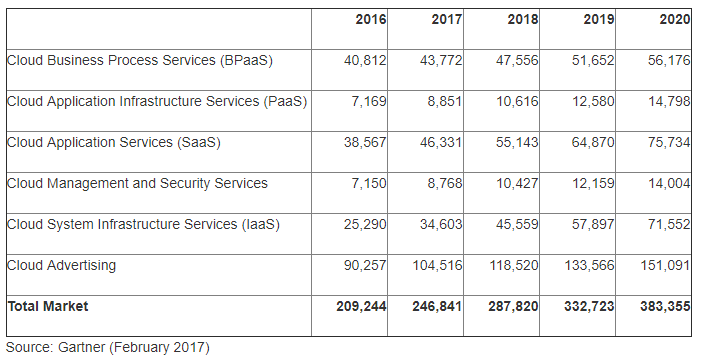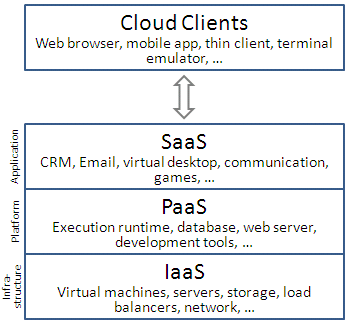Posts Tagged EA874
The Future of the Cloud
The Enterprise Application Architecture, Part 3
So technology has been moving to the “cloud” over the past number of years. More and more of the applications, hardware and devices we use all utilize distributed technology to some degree or another. Each year, top technology companies predict trends for the growth of cloud technologies. It was interesting to see what some of the 2017 predictions have been so far.
IDC (International Data Corporation):
Total spending on IT infrastructure products (server, enterprise storage, and Ethernet switches) for deployment in cloud environments will increase 15.3% year over year in 2017 to $41.7B. IDC predicts that public cloud data centers will account for the majority of this spending ( 60.5%) while off-premises private cloud environments will represent 14.9% of spending. On-premises private clouds will account for 62.3% of spending on private cloud IT infrastructure and will grow 13.1% year over year in 2017.
Gartner:
Gartner predicts the worldwide public cloud services market will grow 18% in 2017 to $246.8B, up from $209.2B in 2016. Infrastructure-as-a-Service (IaaS) is projected to grow 36.8% in 2017 and reach $34.6B. Software-as-a-Service (SaaS) is expected to increase 20.1%, reaching $46.3B in 2017.
Source: Gartner Says Worldwide Public Cloud Services Market to Grow 18 Percent in 2017.
Forrester:
- Cloud computing has been one of the most exciting and disruptive forces in the tech market in the past decade. And it’s no longer an adjunct technology bolted onto a traditional infrastructure as a place to build a few customer-facing apps. Cloud applications (SaaS), business services, and platforms (IaaS/PaaS) now power a full spectrum of digital capabilities, from the core enterprise systems powering the back office to the mobile apps delivering new customer experiences.
- The cloud market will accelerate even faster in 2017. Enterprises use multiple clouds today, and they’ll use even more in 2017 as CIOs step up to orchestrate cloud ecosystems that connect employees, customers, partners, vendors, and devices to serve rising customer expectations.
- Some will push further, shifting from being cloud adopters to becoming cloud companies themselves. Following early examples like GE or Bosch, these companies will become stewards of their own client and product ecosystems.
- Cloud expansion will exacerbate the cloud management challenge, pushing CIOs to also aggressively tap new and maturing enterprise-grade security, networking, and container solutions
Source: 2017 Predictions: Dynamics That Will Shape The Future In The Age Of The Customer
Oracle:
- Cloud-based mission-critical workloads will take off. Cloud has long promised the migration of all enterprise production workloads. But that migration has yet to happen. The chief barrier to cloud migration remains a lack of commitment and recourse to support production service-level agreements. On one hand, cloud providers are limiting their accountability as they lack the talent to support custom portfolios. On the other, they’re failing to provide sufficient control into the public data center to self-manage service-level agreements. The IaaS provider best equipped to take more responsibility and deliver the control tenants demand will be the one to drive cloud migration in 2017.
- Corporate-owned data center numbers will plummet. As organizations focus their IT spending on cloud computing, they’ll begin to migrate their workloads from corporate-owned data centers to purpose-built facilities, managed and run by enterprise cloud providers. Mark Hurd predicts that we’ll see corporate-owned data center numbers fall 80 percent by 2025, and that the same percentage of IT spending will be devoted to cloud services.
- Enterprise cloud becomes the most secure place for IT processing. This year’s threat landscape will be highly changeable. External threats—coupled with the need for better governance and privacy mandates—will make security a key priority for all lines of business. In years past, security was a major barrier to cloud investment. Data sovereignty, data privacy, and control issues deterred many organizations from pursuing cloud adoption. But in the future, those very same concerns will be the things that draw new organizations to the cloud.
- Digital Transformation becomes the norm. Our world is becoming increasingly digitally connected, and it’s transforming the way we live, work, and play. These same technological advancements provide unprecedented opportunities for businesses to expand, innovate, and create new value. Sectors including healthcare, manufacturing, and even urban planning have been reimagined and redefined by the cloud. To realize these opportunities, today’s enterprises must not only develop new cloud-ready tools, but also put digital at the center of their businesses. Hidden within today’s digital connections are the solutions to our most urgent business challenges.
- The Rise of Intelligent Applications. Artificial intelligence (AI) might sound like science fiction, but many of us use it every day. The software behind many online shopping sites and on-demand music services, for example, is a highly successful and highly pervasive form of AI. These systems depend on technology infrastructure capable of importing, analyzing, and interpreting huge volumes of data before acting on it—all without human intervention. And the next step for such technologies? To become an established part of customer service and other business operations.
- AI gets real. AI and robotics have carved out a niche in the manufacturing sector, and now these technologies are poised to bring their exciting benefits to a host of new industries. The AI space is white-hot, and it’s being fueled by the data explosion. Machine learning algorithms find patterns in enormous volumes of digital information and use that data to train, learn, and become even smarter. CIOs ignore the AI wave at their peril. According to Toby Redshaw, consultant and former American Express CIO, the company that ignores AI-powered technology will be “the guy at the gunfight with a knife.”
- Developers do more with less coding. This year, a new tool looks set to join cloud app developers’ toolkits. “Visual” or “low” coding will be everywhere in 2017. For many organizations, the real-time enterprise has meant a rethink of application development. IT teams are often stuck with a backlog of work, preventing them from delivering applications quickly enough to capitalize on new opportunities. Visual coding enables quick, straightforward development and extension of enterprise applications. “More than ever before, application development and delivery professionals must obsess over their UI designs,” say Forrester analysts John Rymer and Clay Richardson. “Low-code vendors employ familiar drag-and-drop, WYSIWYG techniques to speed user interface creation.”
- The Cloud empowers small business innovation. Cloud has become a catalyst for small business growth, allowing them to innovate freely, carve out new markets, and disrupt the status quo. The digital economy demands that companies of all sizes compete based on technology-enabled value. While some seek to evolve existing business practices, others are striving to launch new services that exploit extensive, low-cost computational power. Traditionally, access to such high-performance resources has been too expensive for smaller businesses. But what once cost 100 million USD up front is now available for 10 USD per hour.
- 60 percent of IT organizations move systems management to the cloud. More than 90 percent of companies have multiple systems management tools, but just six percent trust their incomplete data. Consequently, IT operations professionals struggle to create effective management approaches. The pace of business is increasing. As more organizations adopt DevOps practices and focus on digital experience, they’ll need to eliminate management data silos and embrace machine learning just to keep up. Some have already embraced systems management in the cloud, unifying management data across multiple clouds and on premises. Others are benefiting from data science applied to the operational management problem. Only Oracle Management Cloud provides an intelligent, unified, cloud-based approach that applies machine learning to the complete operational data set. And while many cloud tools are built exclusively for cloud systems, ours does both.
- 50 percent of DevTest will move to the cloud. Last year, we predicted that DevTest workloads would have all but completely migrated to the public cloud by 2025. At Oracle OpenWorld 2016, Mark Hurd revealed that “we are nearly halfway there” already. With on-premises hardware and software, IT teams have to buy, license, and configure everything to create development environments that hopefully match production environments. Hurd estimates that the industry could save 150 billion USD by migrating DevTest to the cloud.
Source: Oracle Cloud Predictions 2017
Service Oriented Anarchy
The Enterprise Application Architecture, Part 2
SOA. Sons of A…. I mean Service-Oriented Architecture. What exactly is this? And what’s the big deal?
In Part 1, I talked about Software as a Service, and mentioned Platform as a Service as well as Infrastructure as a Service. Each of those strategies is taking a commonly used aspect of technology and converting it to a service that can be accessed over the Internet. SaaS, as I mentioned in Part 1, is about delivering an application over the Internet to an end consumer, or simply, a distribution method. SOA, on the other hand, is architectural approach for application development, or a development method. By converting all parts of a system to act as independent services, then those same pieces can be used by multiple applications, all having a common framework for communication, referred to as a service bus. These pieces become the building blocks for a larger system, enabling the parts to easily interact with one another.
IBM uses a combination of multiple definitions to elaborate on SOA :
- A set of services that a business wants to provide to their customers, partners, or other areas of an organization
- An architectural style that requires a service provider, mediation, and service requestor with a service description
- A set of architectural principles, patterns and criteria that address characteristics such as modularity, encapsulation, loose coupling, separation of concerns, reuse and composability
- A programming model complete with standards, tools and technologies that supports web services, REST services or other kinds of services
- A middleware solution optimized for service assembly, orchestration, monitoring, and management
The more you search around the Internet, the more varied and diverse definitions you find for SOA. As Martin Fowler, software developer, author and Chief Scientist for ThoughtWorks (a technology consulting company), says in his 2005 article Service Oriented Ambiguity:
- For some SOA is about exposing software through web services. This crowd further sub-divides into those that expect the various WS-* standards and those that will accept any form of XML over http (and maybe not even XML).
- For some SOA implies an architecture where applications disappear. Instead you have core services that supply business functionality and data separated by UI aggregators that apply presentations that aggregate together the stuff that core services provide.
- For some SOA is about allowing systems to communicate over some form of standard structure (usually XML based) with other applications. In it’s worse form this is “CORBA with angle brackets”. In more sophisticated forms this involves coming up with some form of standard backbone for an organization and getting applications to work with this. This backbone may or may not involve http.
- For some SOA is all about using (mostly) asynchronous messaging to transfer documents between different systems. Essentially this is EAI without all the expensive EAI vendors locking you in.
So do we have a better understanding of SOA? Or is it chaos and anarchy? I think his definition by Oracle was simple enough for a begining understanding: “A service-oriented architecture is a way of sharing functions (typically business functions) in a widespread and flexible way.”
Let’s get SaaSsy…!
The Enterprise Application Architecture, Part 1
SaaS. PaaS. IaaS. The Cloud.
What is this gibberish? Is it some foreign or mystical language? What does it mean…?
First of all, let’s clear the air and make one thing absolutely clear:
In it’s simplest form, cloud computing or “The Cloud”, is just a fancy term used to describe distributed computing. Some aspect of the system, whether it’s the storage, data, application, server, etc., is accessed remotely, typically via the internet. Back in the 1990s, this same concept took place, but required dedicated connections either via leased lines or VPN services over existing communication channels. The cost factor of those services was substantial enough that only larger organizations could make it practical for everyday use. As technology became faster and cheaper, the distributed computing services gradually became more available. In addition, with the rapid growth and adoption of the Internet starting in the mid 90s, more computing services were being made available to individual consumers. Once service providers realized the potential revenue from this technology, it wasn’t long before entire businesses were created around the provision and sale of “cloud” computing services. Amazon’s debut in 2006 of Elastic Compute Cloud services pushed the technology further and now there are many large scale providers of cloud services and it’s a common term both within the IT industry and to many consumers.
Building on that basic framework of cloud computing, there are various level of service that can be provided (Wikipedia – Cloud Computing):
- SaaS – Software as a Service: The capability provided to the consumer is to use the provider’s applications running on a cloud infrastructure. The applications are accessible from various client devices through either a thin client interface, such as a web browser (e.g., web-based email), or a program interface. The consumer does not manage or control the underlying cloud infrastructure including network, servers, operating systems, storage, or even individual application capabilities, with the possible exception of limited user-specific application configuration settings.
- PaaS – Platform as a Service: The capability provided to the consumer is to deploy onto the cloud infrastructure consumer-created or acquired applications created using programming languages, libraries, services, and tools supported by the provider. The consumer does not manage or control the underlying cloud infrastructure including network, servers, operating systems, or storage, but has control over the deployed applications and possibly configuration settings for the application-hosting environment.
- IaaS – Infrastructure as a Service: The capability provided to the consumer is to provision processing, storage, networks, and other fundamental computing resources where the consumer is able to deploy and run arbitrary software, which can include operating systems and applications. The consumer does not manage or control the underlying cloud infrastructure but has control over operating systems, storage, and deployed applications; and possibly limited control of select networking components (e.g., host firewalls).
(Image Source: Wikipedia – Cloud Computing)
So SaaS specifically is the distribution of applications/software. Typically, a SaaS application is accessed and delivered via a web browser. A prime example of a SaaS application that many of us use today is Dropbox or Google Drive. We have a service that provides access to files that are stored remotely on a server somewhere. We are not directly accessing that remote server, but instead it’s the application (whether a desktop application or a web-page) that lets us access our files. Google Drive is part of a larger application group that also includes email, calendar, chat, word processing, spreadsheets, presentations and forms. Other large companies such as Microsoft and Amazon, as well as vendors such as Workday, Salesforce and Concur have all quickly joined the SaaS marketplace with solutions.
So what are the benefits of pursuing a SaaS strategy? Here is a short list as compiled by IBM:
- Lower Cost – First, SaaS applications are subscription based. There are no licensing fees and no initial costs. This will typically translate to lower overall costs compared to the implementation of a similar traditional application.
- Reduced Time to Live – Secondly, there is a drastic difference in time-to-live. Since there is no hardware or backend processes that need to be installed and configured ahead of time, time to the application being live is shortened. Then, in addition, the simple benefit of the application already being installed and running on the remote servers reduces the time as well. In most cases, configuration and setup is a simple process which takes at most a couple of hours.
- Painless upgrades – Considering that the actual application resides on a remote server maintained by the vendor, the end user doesn’t have any action needed to perform updates to the software. This is all managed remotely in the back end and is typically seamless to the end user.
However, it’s not all positive. Two of the biggest issues that companies have with SaaS services are Security and Outages. How secure is my data and business info? What happens if hackers get into the data center where it is hosted? What happens when the hosting location has an outage? How will I be able to utilize the application during that time? Will I be compensated for the outage?
Ultimately, the pros and cons have to be weighed against the specific circumstances that you envision for the SaaS services. Each company will have different levels of needs and justifications that will determine whether it is the right solution for them or not.
How do you Adopt?
Digital Disruption, Part 3
Originally in 1962, and most recently in 2003, professor Everett Rogers detailed a systematic system by which innovation is adopted. In his book, Diffusion of Innovations, Rogers states that adopters of innovation (or in our current discussion, technology) can be broken down into 5 distinct groups of Innovators, Early Adopters, Early Majority, Late Majority and Laggards.
Image Source: phdsoft
Rogers breaks down the 5 categories as such (Rogers, 2003):
- Innovators – 2.5% of the population. Innovators are willing to take risks, youngest in age, have the highest social class, have great financial lucidity, very social and have closest contact to scientific sources and interaction with other innovators. Their high risk tolerance gives them the flexibility to try new technologies that are not yet proven out.
- Early Adopters – 13.5% of the population. These individuals have the highest level of opinion leadership (the process by which a person influences the attitudes or actions of another person informally) among all the adopter categories. Early adopters are typically younger in age, have a higher social status, have more financial lucidity, advanced education, and are more socially forward than late adopters. They tend to be more discreet in adoption choices than the early adopters which enables them to have a greater voice in opinions.
- Early Majority – 34% of the population. They adopt innovation after a varying degree of time, which is significantly longer than innovators and early adopters. Early Majority have above average social status, contact with early adopters and seldom hold positions of opinion leadership in a system.
- Late Majority – 34% of the population. These individuals will adopt innovation after the average adopter. They approach an innovation with a high degree of skepticism. Late majority adopters have below average social status, little financial liquidity, and very little opinion leadership.
- Laggards – 16% of the population. They are the last to adopt an innovation. These individuals typically have no opinion leadership at all, they have an aversion to change-agents, and tend to be advanced in age. Laggards typically tend to be focused on “traditions”, likely to have lowest social status, lowest financial fluidity, be oldest of all other adopters, and socially in contact with only family and close friends.
This breakdown by Rogers was based on many years of research and market study. We can see that age, social status, finances and personal influence have a large impact on the categories of adopters. This makes sense as younger people are typically overall more willing to take risks compared to older generations. The amount of finances available to you also directly impacts the level of risks you are willing to take. And the social aspect is a fascinating addition to the equation. The more socially connected you are, the higher the chance of you finding out about a new innovation. Word of mouth at first, and then marketing later can help spread information regarding new innovations, allowing more and more individuals to investigate the innovation and decide on their participation.
This same model converts directly into the business environment. Business Analyst Daniel Newman described in Forbes magazine how those same 5 categories apply to people within your organizations (Newman, 2016):
- Innovators – Innovators are the visionaries willing to try new ideas and take risks along the way.
- Early adopters – People in this category are the thought leaders and change drivers within an organization. They may not express a willingness to try anything that comes along, but they’re comfortable with change and helping others understand the importance of change. Some organizations refer to these individuals as technology champions.
- Early majority – These individuals aren’t thought leaders, but they are the people you see lined up outside of a store on the day a new technology comes to market. As soon as they see the demonstrated benefits of a change, they’re willing to jump on board.
- Late majority – Typically skeptics, this population waits until a larger population adopts an innovation to invest time and effort making a change.
- Laggards – Every organization has individuals “stuck in their ways.” Convincing these individuals to make a change is challenging.
Newman goes on to say that in order for organizations to be able to adopt new technologies, individuals within the organization need to demonstrate the Innovator, Early Adopter and Early Majority traits in order to successfully integrate the technology at a reasonable pace.
Are you an Innovator? An Early Adopter? Or are you a Laggard? A simple look at the technology you use day-to-day may tell others more than you realize.
References:
Newman, Daniel. (2016). Why you should align your Business Transformation too the Adoption Bell Curve. Forbes. Retrieved August, 30, 2017 from https://www.forbes.com/sites/danielnewman/2016/05/31/why-you-should-align-your-business-transformation-to-the-adoption-bell-curve/#264c11721160
Rogers, Everett. (2003). Diffusion of Innovations. Free Press.
Disruptors set to Maximum….
Digital Disruption, Part 2
(for the non Star Trek fans in the room, Klingons typically use a weapon called a disruptor)
So what do we mean when we say that technology is disruptive? A simple definition, as provided by Technopedia, is “Disruptive Technology refers to any enhanced or completely new technology that replaces and disrupts an existing technology, rendering it obsolete.” Disruptive technology can be hardware, software, networks, new processes and any combination of those as well. Typically, the success of a disruptive technology is unexpected. This is due to the fact that most disruptive technologies lack refinement, have some performance problems, are only known to a limited audience and may not yet have practical applications at the time of their creation (Christensen, 1997). It’s not until later, once some of those issues are addressed, that the existing technology starts to be impacted and potentially threatened.
Another aspect of disruptive technology is that once it starts being adopted, it has the potential to transform the way we live and work, enable new business models, and provide a way for new companies to upset or disrupt the established order (Manyika, et.al. 2013). At first glance, that may seem exaggerated, yet consider this list of technologies that were/are considered as disruptive at their time in history:
- Steam Power
- Assembly Line Manufacturing
- World Wide Web / Internet
- Personal Computer
- Mobile Phones / Smartphones
- Video Streaming
- Cloud Technology
There are hundreds more examples of technology that we take for granted today, which when it became public, it may not have been well accepted. I doubt any of the original creators of these ideas had a concept of how great an impact their creation would have on the future society. And the technologies that were replaced were firmly entrenched as the “leaders” of their realm. Yet, can we image a world today without any of these technologies? And if these technologies alone had such a huge impact on our society, then what is in store in the future? There are emerging technologies that we see today such as 3D printing, self-driving vehicles, robotics & AI, the Internet of Things, and virtual reality. We can already begin to see the impact these technologies have on consumers and companies are starting to be impacted as well.
What’s the next big thing around the corner and how much will it change our society? And how do we adopt these new technologies?
References:
Christensen, C. (1997). The Innovator’s Dilemma: Management of Innovation and Change. Harvard Business School Press.
Manyika, J., Chui, M., Bughin, J., Dobbs, R., Bisson, P., & Mars, A. (2013). Disruptive Technologies: Advances that will transform life, business and the global economy. McKinsey Global Institute. Retrieved August 29, 2017 from http://www.mckinsey.com/business-functions/digital-mckinsey/our-insights/disruptive-technologies








